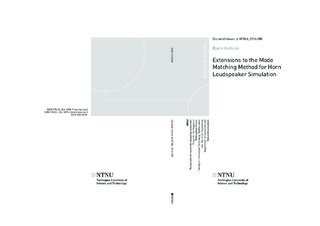Extensions to the Mode Matching Method for Horn Loudspeaker Simulation
Doctoral thesis
Permanent lenke
http://hdl.handle.net/11250/2415853Utgivelsesdato
2016Metadata
Vis full innførselSamlinger
Sammendrag
For loudspeaker horns, the throat acoustic impedance and the far
field directional characteristics are important measures of performance.
Both quantities depend greatly on the shape of the horn, and
the acoustical conditions at the mouth of the horn.
The Mode Matching Method (MMM) is a semianalytical method
for the simulation of sound propagation in ducts, and is the method
used as the fundamental building block in this work. In previous
work using this method, the horn has usually been assumed to be
mounted in an infinite baffle, a condition that is not realistic for most
real-world applications. Most horns are usually mounted in finite baffles
or cabinets, or placed close to reflecting surfaces or in rooms.
This work has therefore focused on extending the MMM to new cases
closer to real-world applications.
For horns without baffle, or with finite baffles or flanges, two methods
have been explored; one for axisymmetric horns based on the
solution for a semi-infinite unflanged duct, and one for general geometries
based on edge diffraction. For horns near infinite reflecting
surfaces, a method has been derived to compute the modal mutual radiation
impedance. For the final radiation condition, a horn mounted
in the wall of a room, two methods have been explored, where in
both cases analytical expressions for radiation impedance and radiated
pressure are found for shoebox shaped rooms. Experimental
verification of some of the cases mentioned above is provided.
The MMM is restricted to certain cross-sectional geometries; round
and rectangular geometries are treated in this work. In many practical
cases a rectangular horn is connected to a circular loudspeaker,
and in order to simulate this and similar configuration, a method has
been developed to interface the MMM with the Boundary Element
Method.
By modifying the MMM, it has also been possible to simulate radiation
from concave structures like loudspeaker diaphragms. Using
this approach it is also possible to simulate concave reflectors, as long
as the source is not outside of the cavity.
A final application of the MMM in this work, is the use of the
method to compute the transfer function and resonance frequencies
of non-shoebox shaped rooms. While the shape of the room is still
somewhat restricted compared to Finite Element Method simulations,
a wide range of rooms can be simulated.
